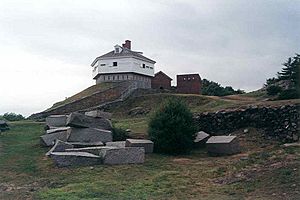Fort McClary facts for kids
Quick facts for kids |
|
|
Fort McClary
|
|

The renovated blockhouse of Fort McClary dating from 1844, which now serves as a museum
|
|
| Location | Off ME 103 at Fort McClary State Historic Site |
|---|---|
| Nearest city | Kittery Point, Maine |
| NRHP reference No. | 69000025 |
| Added to NRHP | October 1, 1969 |
Fort McClary is an old fort in Kittery Point, Maine. It sits right at the mouth of the Piscataqua River. For many years, this fort helped protect the important harbor of Portsmouth, New Hampshire. It also guarded the Portsmouth Naval Shipyard nearby. Today, Fort McClary is a fun place to visit. It's called the Fort McClary State Historic Site. You can see its old buildings, including a special wooden building called a blockhouse from 1844.
Contents
Fort McClary: A Look Back in Time
Fort McClary has a long and interesting past. People have built defenses on this spot for hundreds of years. It has seen action during many important times in American history.
Early Defenses and Colonial Times
The first defenses here were built around 1689. A shipbuilder named William Pepperell owned the land. He put up simple defenses to protect the area. Before this, another fort, Fort William and Mary, protected the village.
In 1715, the government decided to build a stronger defense. They wanted a permanent wall with six cannons. This was to protect the Piscataqua River. It also helped collect taxes from ships. This early fort was later given to the U.S. government in 1803. It was known as Fort William.
During the American Revolution in 1775, the Pepperell family stayed loyal to Britain. So, American Patriot forces took over their property, including the fort. By 1776, the fort had cannons and was guarded by soldiers.
Building a Stronger Fort: The Second System
Fort McClary officially became a U.S. military fort in 1808. This was part of a plan to build many forts along the coast. It was named after Major Andrew McClary. He was an American officer who died in the Battle of Bunker Hill in 1775.
The fort had a lower area with 9 or 10 cannons. It also had a special furnace to heat cannonballs. There was an upper area too, near where the blockhouse is today. The fort was used during the War of 1812. However, it never saw any actual fighting.
Civil War Era and New Construction
The fort grew even more in the 1840s. This was because of disagreements with Great Britain. These disagreements were about the border between Maine and Canada. They led to a peaceful event called the Aroostook War.
The famous blockhouse was built in 1844. It was one of the last blockhouses ever built at a U.S. coastal fort. Fort McClary was very active during the American Civil War. Many of its current buildings were started during this time.
Famous People at the Fort
At the start of the Civil War, soldiers from Maine guarded the fort. In 1864, the Maine State Guard also helped. A very famous person served here: Vice President Hannibal Hamlin. He joined the Maine State Guard as a private. He even worked as a cook at the fort!
Unfinished Plans
The fort didn't see much fighting during the Civil War. In 1863, a big plan began to make the fort even larger. The idea was to build a huge, five-sided fort with many cannons. But only the walls facing the sea were finished. One land-facing cannon area was also built.
However, new cannons could shoot through stone walls. So, the government stopped funding stone forts in 1867. This left Fort McClary with many unfinished parts. You can still see many granite blocks left over from these plans today.
From Military Base to Historic Site
In the 1870s, the lower part of the fort was rebuilt. It had temporary spots for three large cannons. But again, funding was cut. In the 1890s, many huge cannons were stored at the fort. Three of them were set up quickly during the Spanish–American War in 1898.
By 1901, newer, stronger forts like Fort Foster (Kittery, Maine) were built. Fort McClary was no longer as important. By the 1910s, many parts of the fort were falling apart. It was officially closed in 1918.
The State of Maine bought most of the land in 1924. It became a park for people to enjoy. Some old, broken buildings were taken down over the years. During World War II, parts of the fort were used again for defense. In 1969, Fort McClary was added to the National Register of Historic Places. The blockhouse and other buildings were fixed up in 1987. Today, the blockhouse is a museum where you can learn more about the fort's history.
See also




